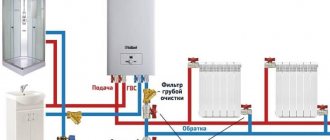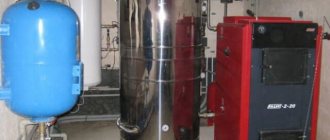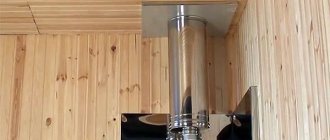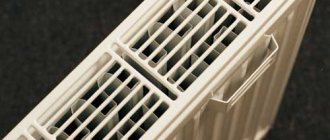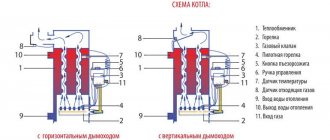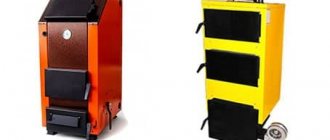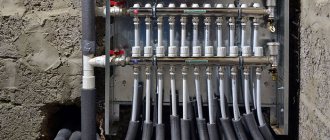Installation sequence
The industry produces several types of solid fuel boilers - pellet, direct combustion and pyrolysis.
However, installation of a solid fuel boiler of any type is carried out using the same method:
- First, determine the location where the boiler will be placed.
- Next, preliminary preparation of the room is performed.
- Equipped with supply and exhaust ventilation.
- Install the selected solid fuel boiler and lay out the chimney.
- Connect it to the general heating system and check its performance with a test run.
Please note that some models of wood or coal boilers require additional power from the mains. This possibility must be provided for at the preparation stage.
Proper completion of preparatory work before installing a solid fuel boiler in the house is of great importance. If you ignore one of the preparation stages, you will inevitably encounter difficulties during the operation of the boiler. Then all the shortcomings will have to be eliminated in the current mode right in the middle of the heating season. Let's consider each of the listed points in more detail.
Boiler location
The regulatory framework that would regulate the installation of a solid fuel boiler in a private home has not yet been developed. However, the basic requirements for the placement of such equipment can be found in SNiP “Heating and Ventilation” and SNiP 31-02-2001 “Single-apartment buildings” (for the Russian Federation), as well as a number of other individual acts.
It is worth noting that the SNiP “Boiler Installations”, which is often mentioned on the Internet, is not designed for low-power household appliances - its requirements apply to equipment with a power of more than 360 kW, and the rules for installing gas equipment are too strict.
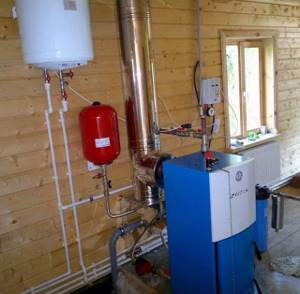
Based on the analysis of the available regulatory framework, which relates to the procedure for placing heating devices on wood, the following tips can be highlighted on how to install a solid fuel boiler in a house:
- Any type of solid fuel, be it wood, coal or pellets, creates a large amount of dust. In addition, during operation of the boiler, varying amounts of smoke may enter the room. In this regard, it is not recommended to install a solid fuel boiler inside the living rooms of the house. Although the regulatory framework does not directly prohibit the installation of a solid fuel boiler in the kitchen, hallway or other rooms, with the exception of the bedroom.
- The best option for placing a solid fuel boiler would be an equipped separate boiler room or one attached to a common house. You can also focus on technical rooms in the house itself, a basement, garage or hallway with good ventilation.
- Heating equipment should be located as close as possible to the outer wall in order to facilitate the work of laying out the chimney, not to create too long a horizontal section or not to lead the pipe through the ceiling.
- Any solid fuel boiler requires periodic cleaning of the heat exchanger and maintenance. Therefore, it is necessary to ensure free access to it. To do this, leave at least 1 m of space in front, and approximately 60 cm in the back and sides, but not less than 25 cm.
- It is prohibited to connect the flue duct of a solid fuel boiler to brick ventilation ducts inside the walls.

Please note that before purchasing a solid fuel boiler, it is advisable to compare its dimensions with the dimensions of the technical room where it is planned to be installed. In addition, it is worth considering in advance the location of the heat accumulator, buffer tank and indirect heating boiler.
In small-sized boiler rooms, heating equipment can be placed quite close to the wall, but only on the unattended side. In this case, the gap can be at least 10 cm, and there must be a gap of at least 25 cm at the back.
Water gas heating system for a private house
The most common heating system is water: the role of heat carrier is played by water, which circulates through a closed pipeline circuit. The water is heated in the boiler and then transfers heat through pipes and heating radiators (batteries).
Such a gas heating system for a private house has several advantages:
- water is an effective coolant;
- the circulation system is closed, so after the initial filling the volume of water should not change;
- water gas heating of a private house, the video, which can be viewed below, will show that such a system can be installed independently;
- in such a system it is easy to create a circuit that ensures uniform heat supply to each room.
Among the disadvantages of a water gas heating system:
- Heating radiators must be kept clean at all times, since if they are covered with dust, the efficiency of heating the premises will be lower;
- in comparison with air heating, water heating, after switching on, will not be able to provide the same rapid heating of the air;
- elements that are part of a water heating system can often crack, corrode, etc. This can not only worsen the microclimate in the house, but also cause damage to the interior of the premises;
- there are special requirements for the quality of the heat carrier: the amount of salts in the water must be minimized;
- The heating cannot simply be turned off in winter, when it is very cold outside, as this can lead to freezing of water, which will increase in volume and burst the pipes. Therefore, gas heating of private houses of this type is not suitable for dachas where the owners do not visit often, especially in winter.
How to prepare the room
Preparatory work before installing a solid fuel boiler with your own hands includes several areas:
- preparing a reliable foundation and pouring a concrete foundation, if necessary;
- making ventilation holes and a gap for the chimney in the wall;
- insulation of flammable floors and walls from fire using sheets of metal, mineralite, basalt cardboard or asbestos cement.
A power supply line must be installed in the boiler room. It will be needed to connect the circulation pump and, possibly, the automation of the boiler itself.
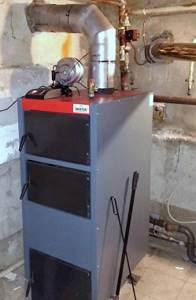
There is no need to get rid of wooden elements on the walls and floor. If the distance from the solid fuel boiler to the wooden wall is less than 38 cm, the casing is insulated with one of the above materials. The same sheet material must be placed on the floor below and in front of the boiler so that it protrudes 80 cm. This will protect the room from coals flying out of the open firebox door.
Recommendations for foundation construction will be as follows:
- Solid fuel boilers with low power and weight up to 200 kg can be installed on a cement screed. As a rule, it copes with such a load.
- With a weight of up to 300 kg, the installation of a solid fuel boiler is carried out on a reinforced concrete screed with a thickness of 10-12 cm. With a weight of more than 300 kg, a separate foundation slab will be required.
- Pellet-fired heat generators with a feed auger and an electric motor require a special type of foundation because they have a vibration load.
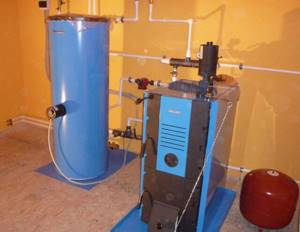
Please note that a small solid fuel boiler can even be installed on a wooden floor. However, its location will have to be reinforced with lags made of beams with a cross-section of 100x50 mm.
If the installation scheme for a solid fuel boiler in a private house requires the presence of a heat accumulator and other heavy elements, there is no need to pour a separate foundation under each of them. In this case, a single concrete screed 12 cm thick is made, reinforced with rods with a cross-section of 8-14 mm. A mesh with a cell of 20x20 cm is made from the reinforcement, which is placed on top of a bed of well-compacted gravel.
Gas heating of a private house
The most economical heating resource today is natural gas. In addition, it is the most affordable. That is why the most optimal option for installing a heating system in a private house is gas heating of a private house. Even if the energy supply is not possible, there are alternative options (gas cylinders, gas holder).

And if there is a gas main in the area, then the installation of gas heating for a private house is greatly simplified. There are several optimal schemes for heating private houses with gas. One of the excellent options for permanent use in a private home is a gas boiler.
How to properly install supply and exhaust ventilation
There are several objective reasons why ventilation in the boiler room is necessary:
- supplying a sufficient amount of oxygen to the boiler to maintain the combustion process;
- removal of carbon monoxide that accidentally entered the room from the furnace outside the premises;
- compensation of the amount of air used during the combustion process.
Please note that to burn 1 kg of firewood you will need 4.6 m3 of air, and burning coal requires about 8-9 m3, based on the quality of the fuel.

Here are some tips for arranging a ventilation system:
- Openings for air inflow and outflow should be located on different sides of the boiler room. The supply opening is made at the bottom of the wall as close as possible to the heat generator, and the exhaust opening is under the ceiling.
- If the boiler is equipped with a smoke exhauster or a blower fan, you should not place the hood next to it (read: “How to choose a smoke exhauster for a solid fuel boiler - types, differences”). Otherwise, the draft will reverse, and the exhaust hole will become a supply hole.
- If the door from a residential building opens into a furnace room, then it is advisable to install a grille for the inlet opening in the door leaf. Warm air entering the boiler will improve the combustion process.
- The size of the exhaust opening should be smaller than the supply opening, since most of the incoming air enters into a thermochemical reaction and exits through the chimney in the form of CO2.
You can calculate the required size of the hood if you multiply the boiler power by 8 - we get the hole area in cm2.
Installation of chimney and boiler
Actually, installing a solid fuel boiler in a house is not some kind of super complicated process. It is enough just to place the equipment on the prepared base and level it horizontally using adjustable legs or special pads. The chimney pipe can be aligned with the hole in the wall by turning the elbows.
It is worth noting that when installing a chimney for a solid fuel boiler, it is best to use insulated sandwich pipes - they will help to avoid the accumulation of condensation on the walls of the chimney. Alternatively, pipe insulation can be done independently using basalt wool.

The fastest and easiest way to assemble an attached external chimney. It consists of a vertical fixed pipe, which is connected to the boiler pipe via a tee. If the house is wooden, then the installation of the chimney where it passes through the wall or ceiling must be carried out in compliance with fire safety regulations.
The chimney installation method is as follows:
- A square hole is cut out in the partition, the size exceeding the cross-section of the chimney pipe by 38 cm on each side. So, with a pipe channel cross-section of 100 mm and a thickness of the insulating layer of 5 cm, the hole size will be 100 + 380 × 2 = 860 mm.
- A galvanized box is mounted in the opening - this will be a passage unit.
- A sandwich pipe is passed through the box, and the voids are filled with basalt wool.
- Fix the outer cover of the unit.
In houses made of brick and foam block, the chimney is mounted in a steel sleeve with a seal.

When installing a heating system with a solid fuel boiler, a number of requirements for chimney ducts must be observed:
- the minimum height of the chimney (from the grate to the canopy) is 5 meters, and there can be no more than three turns;
- the joining of individual sections of the pipe is carried out so that precipitation flows outside the pipe, and accumulated condensate flows inside;
- the horizontal section of the chimney should be installed with a slight slope towards the boiler;
- at the bottom of the chimney there must be a condensate collection tank and an inspection hatch;
- the roof cornice can be bypassed by installing two elbows on the chimney with a slope of 30º;
- the pipe must be secured with brackets so that they do not fall on the joints of the sections;
- A weather vane or cone-shaped cap is mounted on top of the chimney.
Please note that the chimney head must be higher than the wind support zone of the roof of this or a neighboring house in order for the draft to be stable.
Connecting a solid fuel boiler to the system
After the installation of the solid fuel boiler with your own hands is completed and the chimney is in its place, you can proceed directly to connecting the equipment to the general system. The main thing to remember is that cold water should not be supplied to a working boiler, especially if it has a cast iron heat exchanger. Otherwise, due to the temperature difference, sticky condensation will form on the walls of the firebox, which will mix with soot. It will reduce the efficiency of the boiler, and it is quite difficult to clean it.
In this regard, the requirements for installing a solid fuel boiler provide a standard piping scheme with a bypass and a three-way valve. It is set to a fixed temperature of 50-55º, so that the coolant will move in a small circle until its temperature reaches the required values, after which the valve will begin to gradually dilute it with a cold flow from the heating circuit.
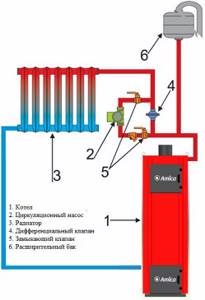
It is worth noting that when piping pellet boilers, special attention should be paid to connecting the burner and automation. Often, products from European brands are equipped with automatic fire extinguishing systems connected to a central water supply. Therefore, in order to figure out how to properly install a solid fuel pellet boiler, you should consult with a representative of the manufacturer.
To connect the boiler, you will also need to install an expansion tank, shut-off valves and a circulation pump. After this, the circuit is filled with water and a pressure of 1 bar is pumped into it. Upon completion of work, a test run of the system is performed to check the functionality.
Heating schemes for a private house
Depending on how the coolant circulates inside a closed loop, there are CO with natural and forced circulation. In the first case, circulation occurs due to the difference in density of cold and hot water, and in the second case, the pump operates. If you want to make a heating system for a private house yourself, then you need to make a careful calculation of the optimal CO scheme.
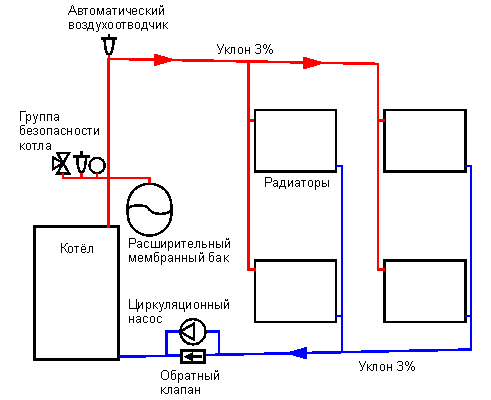
Heating distribution is an important element in the system. It comes in two types:
- single-pipe. It is not often used in private homes, since with such wiring the temperature in the radiators varies. This option is suitable for houses that are small and have few rooms;
- two-pipe. This option is quite material-intensive. But the system is suitable for regulating the temperature in individual rooms.
The single-pipe gas heating scheme for a private house has one significant drawback - the lower radiators heat up less, since they receive slightly cooled water. And if you have a two-story private house, then the rooms on different floors will also warm up unevenly. If you want to equip gas heating with your own hands, then this scheme will be much simpler.
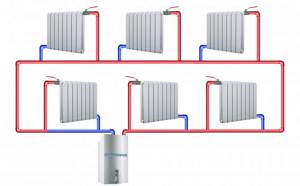
In addition, little material is wasted when laying the pipeline. The problem of uneven heating of radiators is solved by installing a jumper and increasing the number of sections. And to circulate the coolant faster, a circulation pump is used.
Note that a natural circulation scheme will be suitable if it is possible to install the boiler below the level of the radiators. Also, for the normal circulation process to occur, a natural slope of the supply and return pipelines is necessary.
As for artificial circulation, the use of a pump is necessary. Such schemes are quite easy to install, but they have several disadvantages. These include the same uneven heating, as well as the appearance of air jams and dependence on the electrical supply.
Very often you can find such an option as the Leningrad wiring of the heating system (Leningradka). The meaning of this system is that water circulates in a pipe closed to the boiler. Heating equipment (radiators) is connected to it, through which the coolant will flow parallel to the supply circuit. The system is quite effective for a private home.
The next scheme is a two-pipe one. In this case, the radiators will heat evenly, but the cost of laying pipes will be higher. The heating of individual heating radiators can be regulated using special shut-off valves.
A two-pipe system with natural circulation and bottom wiring is well suited when the boiler is located in the basement.
